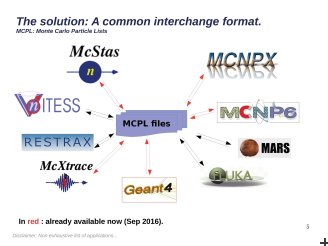Related News
Copyright 2012 neutronsources.org | All rights reserved. | Powered by FRM II | Imprint / Privacy Policy
MCPL: a new format that simplifies data interchange between applications
A team who is part of the SINE2020 e-tools WP launched the first version of MCPL – Monte Carlo Particle Lists. This new, open source format makes it simpler to interchange particle-state information data between popular Monte Carlo simulation packages, making the work of developers more efficient.
Date: 13/12/2016
Source: /sine2020.eu
Contact: Esben Klinkby, Erik Knudsen, Thomas Kittelmann
Scientists occasionally encounter situations in which it would be beneficial to be able to capture a certain subset of particle states present in a given simulation, in order to continue their simulation at a later point. Implementing such capabilities often involves tedious writing of customised code to fit a specific situation. To address this issue, a team part of the SINE2020 e-tools work-package as well as the brightnESS project has developed the Monte Carlo Particle Lists (MCPL) format.
The MCPL format provides flexible yet efficient storage of particle-state information. The aim is to simplify and standardise interchange of such data between applications and processes. MCPL can replace the plethora of custom converters with a more convenient scenario in which experts of each framework implement converters to the common format, as a one-time effort. The idea is that users of the various frameworks can simply activate those pre-existing and validated converters in order to carry out their work.
The core parts of MCPL are implemented in portable and legally unencumbered C code. MCPL interfaces were created for several popular Monte Carlo particle simulation packages such as Geant4, MCNP, McStas and McXtrace. The code has been made freely available under the CC0 1.0 Universal Creative Commons license so that anyone who finds it useful may adopt it into existing packages and build-systems, and create converters and plugins specific for the applications they use. The first version of MCPL has been released recently and further details are explained in this paper. All updates will be available at the MCPL website.
MCPL applications: ESS, cosmic showers, and others
The idea for developing the MCPL format arose from the requirements of simulations at neutron scattering facilities. Monte Carlo simulations are a popular technique to study the transport and interaction of particles and radiation, with applications in a range of fields such as high energy and nuclear physics, space, and medical science.
MCPL is already in use. At the European Spallation Source (ESS) it was used to optimise the detectors for the LoKI instrument. As the detector development progresses in parallel with the general instrument design, it is crucial to be able to optimise the detector setup for the exact instrument conditions under investigation in McStas. The neutrons emerging from the sample in McStas are transferred via MCPL to the detector simulation in Geant4, where a detailed detector geometry and appropriate materials are implemented.
Another example was the use of MCPL to demonstrate a useful method for disentangling the simulation of cosmic showers from subsequent faster simulations of neutron transport in the Earth crust. The simulation strategy employed eases the use of computational resources, and provides a means for cross-comparison between simulation codes.
Please let your colleagues who use relevant applications know about MCPL.
Original Publication Submission
- T. Kittelmann, E. Klinkby, E. B. Knudsen, P. Willendrup, X. X. Cai, K. Kanaki, Monte Carlo Particle Lists: MCPL http://inspirehep.net/record/1486049
- MCPL website: https://mctools.github.io/mcpl/



